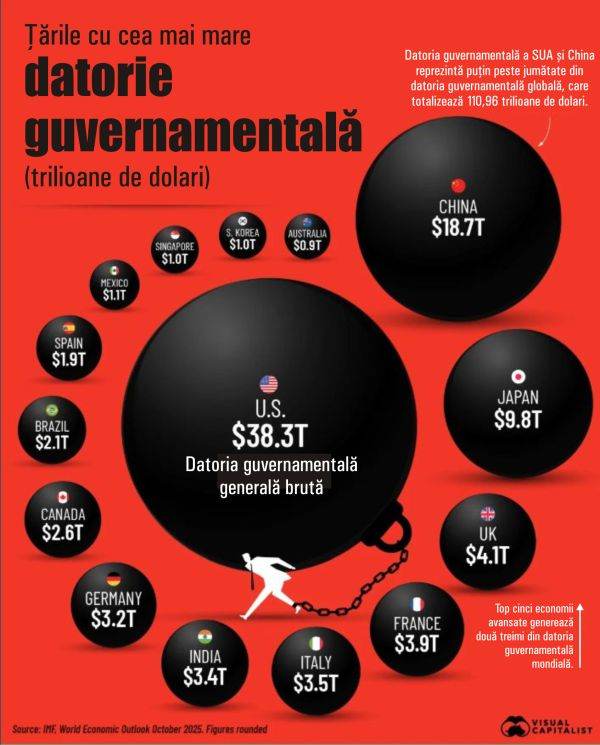Global public debt reached almost $111 trillion in 2025, and the countries with the highest overall gross public debt are advanced economies, according to data from the International Monetary Fund (IMF). A visualcapitalist.com analysis shows, based on the IMF's latest World Economic Outlook report, published in October 2025, that the top five countries alone - the United States, China, Japan, the United Kingdom and France - hold two-thirds of global public debt, totaling $74.8 trillion. Debt values were determined using each country's debt-to-GDP ratio and current GDP for 2025.
• United States leads the rankings, with a public debt of $38.3 trillion
The United States continues to lead the rankings, with a public debt of $38.3 trillion, which represents just over a third of global debt, according to the IMF. China and Japan follow, with $18.7 trillion and $9.8 trillion, respectively, meaning the top three countries together hold 60% of the world's debt. The United Kingdom, France and Italy follow, with public debts of $4.1 trillion, $3.9 trillion and $3.5 trillion, respectively. These advanced economies have long carried large debt burdens, both in monetary terms and relative to their GDP, due to sustained fiscal programs and aging populations.
Up to 15th place, the ranking of gross public debt in 2025 looks like this, according to IMF data: India ($3.36 trillion), Germany ($3.23 trillion), Canada ($2.60 trillion), Brazil ($2.06 trillion), Spain ($1.90 trillion), Mexico ($1.10 trillion), Singapore ($1.01 trillion), South Korea ($0.99 trillion), Australia ($0.93 trillion).
• Government Debt Dynamics in Major Economies
Although the US has a debt value that is slightly more than double that of China, the annual growth of public debt in both countries in 2025 was not as significant. US government debt increased by $2.9 trillion in 2025, and China's by $2.2 trillion. Despite the smaller dollar value, China's debt increased more in percentage terms - by 13.6% annually, compared to US debt growth of 8.4%.
Although Japan is known for its high debt-to-GDP ratio of 230%, in 2025 the country recorded a decrease in its debt-to-GDP ratio, as it increased its government debt by only about $200 billion, or 2% in percentage terms.
• IMF urges countries to reduce debt
The highly uncertain outlook makes fiscal reforms more important than ever, and the International Monetary Fund is urging both advanced and developing economies to reduce their debt levels, deficits and strengthen their capital reserves, according to the IMF's Fiscal Affairs Department Director, Vitor Gaspar.
The IMF warned in a report published this month that rich countries already have public debt levels of more than 100% of GDP, or are on track to exceed this level, including the United States, Canada, China, France, Italy, Japan and Britain.
By 2029, global public debt is expected to exceed 100% of GDP, reaching its highest level since 1948 and continuing its upward trend, according to the IMF, which is urging countries to strengthen their capital reserves to protect themselves against economic risks, Reuters reports, according to Agerpres.
The IMF official explained that by the end of the decade, the level of global public debt could reach 123% of GDP, "in the case of an adverse but plausible scenario”, close to the record level of 132% of GDP after World War II.
"From our point of view, the most worrying situation would be one in which there would be financial turbulence”, Vitor Gaspar said in an interview, citing the IMF report which shows that financial markets are getting too used to risks, such as trade wars, geopolitical tensions and large government deficits which, combined with already overvalued assets, increase the chances of a "disorderly” correction of the markets. These developments could lead to a downward fiscal-financial spiral, similar to the one that emerged during the European sovereign debt crisis that began in 2010, Gaspar said, noting: "With significant risks on the horizon, it is important to be prepared, and preparations require capital buffers that allow authorities to respond to severe shocks in the event of a financial crisis.
IMF research shows that countries with more fiscal space are better able to limit the negative effects on the labor market and the economy in the event of severe shocks, combined with a financial crisis.”
Borrowing is now much more expensive than in the period between the 2008 global financial crisis and the pandemic that began in 2020. The increase in interest rates is putting pressure on budgets, at a time when needs are high, amid geopolitical tensions, extreme weather events and an aging population, the IMF official said, adding: "While we recognize that the fiscal equation is difficult for politicians to introduce, now is the time to prepare, targeted measures for spending allocated to education and infrastructure, which will increase GDP.”
Allocating just one percentage point of GDP compared to the current level of spending on education and other investments in human capital, GDP could increase by more than 3% by 2050 in economies advanced economies, and almost double in emerging and developing countries, according to the IMF.



























































